Last updated: October 26, 2021
Article
Cruise Ship – Humpback Whale Encounters In and Around Glacier Bay National Park and Preserve, Alaska
By Karin Harris and Scott Gende
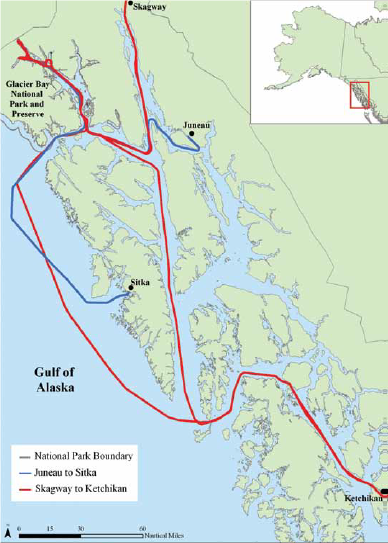
Abstract
Understanding how the presence of cruise ships may affect humpback whales is a research priority for managers of Glacier Bay National Park and Preserve. An observer boarded cruise ships in 2008 and 2009 to docu-ment how often and how close ships encountered whales as ships transited the park and adjacent waters. Results from this study can inform managers of the frequency and severity of encounters and assist them in evaluating policy options that seek to balance visitor experience with protection of valuable biological resources.
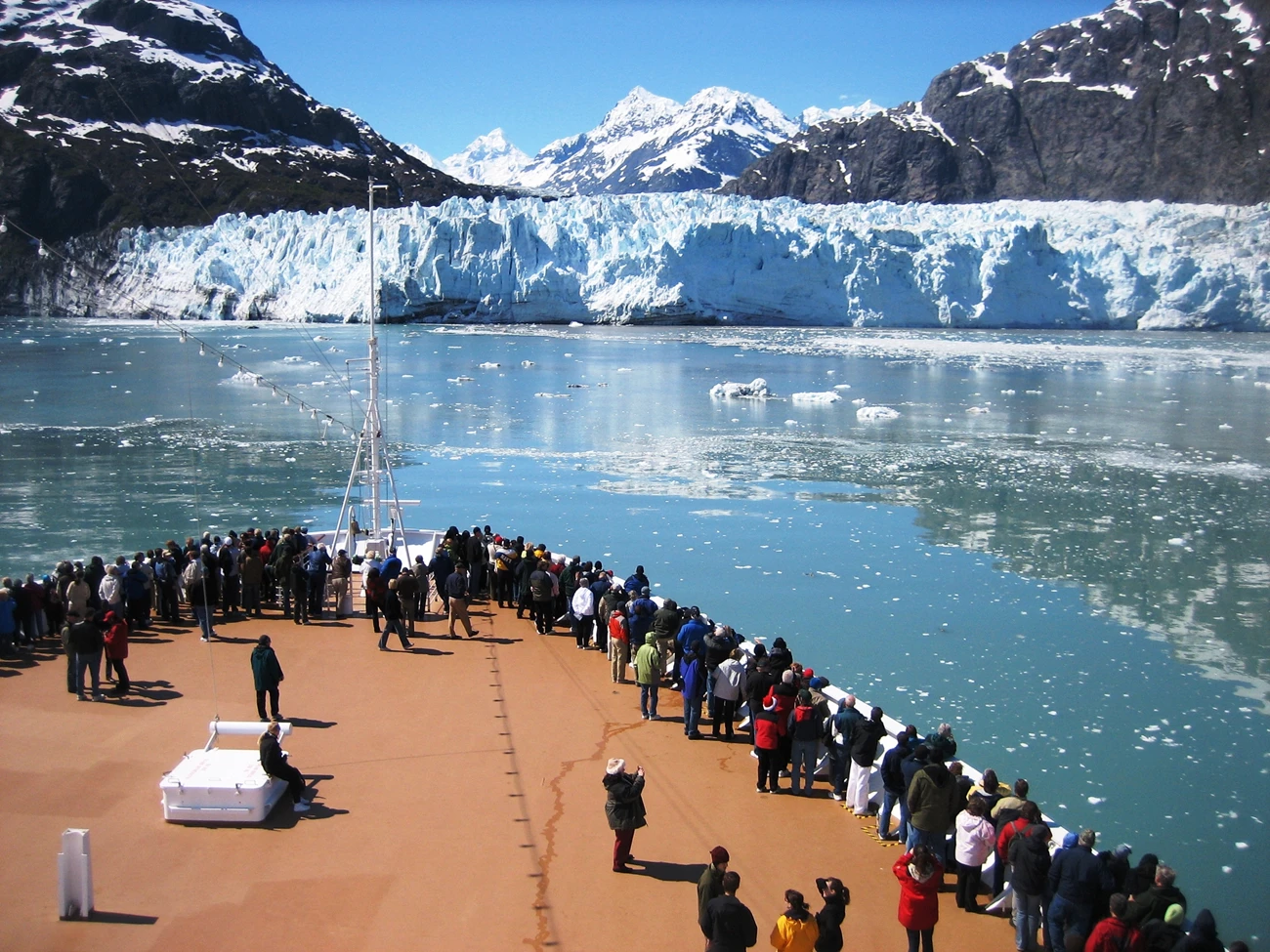
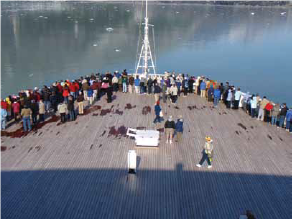
Introduction
Information on how often and how close cruise ships encounter humpback whales can help managers decide how many cruise ships should be allowed to enter thepark each season. This type of information can also be used to develop policies designed to minimize potential impacts to natural resources like humpback whales while also providing opportunities for visitors to enjoy these resources. Currently Glacier Bay National Park and Preserve (GLBA) limits the number of cruise ships to no more than 2 ships per day and no more than 153 during the peak season, which is June to August (36 C.F.R. pt. 13, 2006). The park also enforces additional protection measures such as speed restrictions in portions of the park, where the probability of whale occurrence is high. Two lethal injuries to whales from ship strikes have been confirmed in the park, one in 2001 when a large cruise ship collided with and killed an adult humpback whale (Doherty and Gabriele 2001) and another in 2004 when a humpback whale calf washed ashore in park waters with injuries attributed to a collision with a vessel (Doherty and Gabriele 2004). In Southeast Alaska, there has been an increase in reporting of ship and whale collisions (Gabriele et al. 2007), yet few data exist that documents the frequency and severity of encounters. Expanding on a shipboard observer project initiated within GLBA in 2006, a graduate student from the University of Washington was given a unique opportunity in 2008 and 2009 to travel aboard cruise ships and document the frequency (how often) and severity (how close) of encounters between cruise ships and whales both inside and outside the park. The study was designed to identify locations where ships encountered whales most frequently in Glacier Bay and adjacent waters.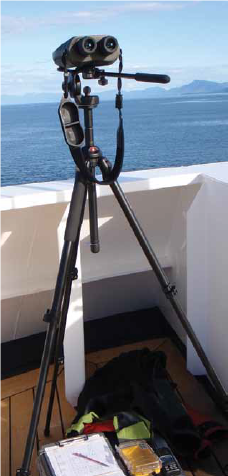
Methods
Observations of encounters between cruise ships and humpback whales in GLBA and adjacent waters were conducted from May to September, 2008 and 2009, from the bow of six different Holland America cruise ships. The observer spent two nights on board cruise ships, boarding in Skagway or Juneau the day before a ship’s scheduled arrival into the park and disembarking in Ketchikan or Sitka (Figure 1). The observer coordinated with agents from the Holland America Line, Cruise Line Agencies of Alaska and U.S. Customs and Border Protec-tion on embarkation and disembarkation procedures.Day 1. Once onboard the cruise ship, the observer coordinated with the chief officer to obtain a hand-held radio. The radio was used by the observer at the bow to communicate with officers on the bridge in the event a whale strike was imminent.
Day 2. The observer proceeded to the bow when the cruise ship was in Icy Strait, and depending on daylight, began observations as early as 4 am (Figure 2). Once at the bow, laser range finder binoculars and hand-held binoculars were used to look for whales. A hand-held GPS unit was used to record both the ship track during observations and the geographic location of the ship when a whale was observed (Figure3). When a whale was observed, distance and bearing as determined from the laser range finder binoculars were recorded onto a datasheet and later entered into a Microsoft Access database. Observations were not conducted when ships were in the upper west arm north of Composite Island because whales are rarely sighted in these waters, and because it was an opportunity for the observer to take a break. Depending on the route taken by a cruise ship, observations continued as daylight allowed in Cross Sound or Chatham Strait (Figure 4).
Day 3. Upon arrival to Ketchikan or Sitka, the observer met with agents from U.S. Customs and Border Protection and Cruise Line Agencies of Alaska before disembarking from the ship. Thesame procedures were followed for each cruise.
For results presented here, encounters at distances less than 100 yards (90 m) were considered close en-counters. Future analysis will be directed at measuring whale response times to the presence of cruise ships to improve our understanding of close encounters.
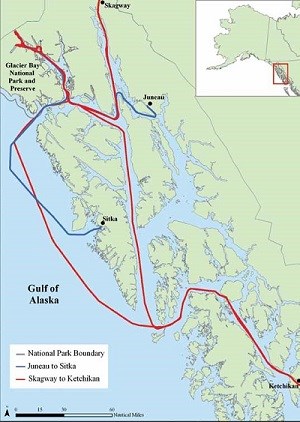
In 2008, cruise ships traveled through inside waters to Ketchikan, whereas in 2009 ships ventured into outside waters.
Abstract
Understanding how the presence of cruise ships may affect humpback whales is a research priority for managers of Glacier Bay National Park and Preserve. An observer boarded cruise ships in 2008 and 2009 to docu-ment how often and how close ships encountered whales as ships transited the park and adjacent waters. Results from this study can inform managers of the frequency and severity of encounters and assist them in evaluating policy options that seek to balance visitor experience with protection of valuable biological resources.Introduction
Information on how often and how close cruise ships encounter humpback whales can help managers decide how many cruise ships should be allowed to enter the park each season. This type of information can also be used to develop policies designed to minimize potential impacts to natural resources like humpback whales while also providing opportunities for visitors to enjoy these resources. Currently Glacier Bay National Park and Preserve (GLBA) limits the number of cruise ships to no more than 2 ships per day and no more than 153 during the peak season, which is June to August (36 C.F.R. pt. 13, 2006). The park also enforces additional protection measures such as speed restrictions in portions of the park, where the probability of whale occurrence is high. Two lethal injuries to whales from ship strikes have been confirmed in the park, one in 2001 when a large cruise ship collided with and killed an adult humpback whale (Doherty and Gabriele 2001) and another in 2004 when a humpback whale calf washed ashore in park waters with injuries attributed to a collision with a vessel (Doherty and Gabriele 2004). In Southeast Alaska, there has been an increase in reporting of ship and whale collisions (Gabriele et al. 2007), yet few data exist that documents the frequency and severity of encounters. Expanding on a shipboard observer project initiated within GLBA in 2006, a graduate student from the University of Washington was given a unique opportunity in 2008 and 2009 to travel aboard cruise ships and document the frequency (how often) and severity (how close) of encounters between cruise ships and whales both inside and outside the park. The study was designed to identify locations where ships encountered whales most frequently in Glacier Bay and adjacent waters.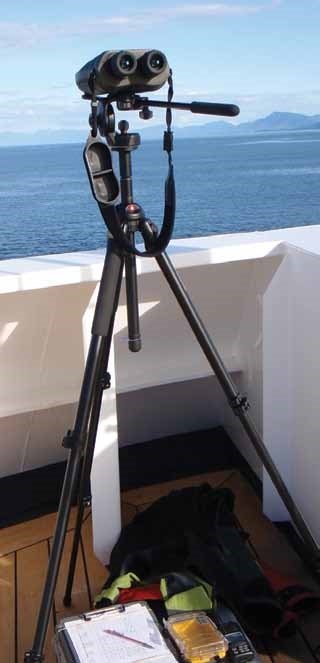
Methods
Observations of encounters between cruise ships and humpback whales in GLBA and adjacent waters were conducted from May to September, 2008 and 2009, from the bow of six different Holland America cruise ships. The observer spent two nights on board cruise ships, boarding in Skagway or Juneau the day before a ship’s scheduled arrival into the park and disembarking in Ketchikan or Sitka (Figure 1). The observer coordinated with agents from the Holland America Line, Cruise Line Agencies of Alaska and U.S. Customs and Border Protec-tion on embarkation and disembarkation procedures.Day 1. Once onboard the cruise ship, the observer coordinated with the chief officer to obtain a hand-held radio. The radio was used by the observer at the bow to communicate with officers on the bridge in the event a whale strike was imminent.
Day 2. The observer proceeded to the bow when the cruise ship was in Icy Strait, and depending on daylight, began observations as early as 4 am (Figure 2). Once at the bow, laser range finder binoculars and hand-held binoculars were used to look for whales. A hand-held GPS unit was used to record both the ship track during observations and the geographic location of the ship when a whale was observed (Figure 3). When a whale was observed, distance and bearing as determined from the laser range finder binoculars were recorded onto a datasheet and later entered into a Microsoft Access database. Observations were not conducted when ships were in the upper west arm north of Composite Island because whales are rarely sighted in these waters, and because it was an opportunity for the observer to take a break. Depending on the route taken by a cruise ship, observations continued as daylight allowed in Cross Sound or Chatham Strait (Figure 4).
Day 3. Upon arrival to Ketchikan or Sitka, the observer met with agents from U.S. Customs and Border Protection and Cruise Line Agencies of Alaska before disembarking from the ship.
The same procedures were followed for each cruise. For results presented here, encounters at distances less than 100 yards (90 m) were considered close en-counters. Future analysis will be directed at measuring whale response times to the presence of cruise ships to improve our understanding of close encounters.
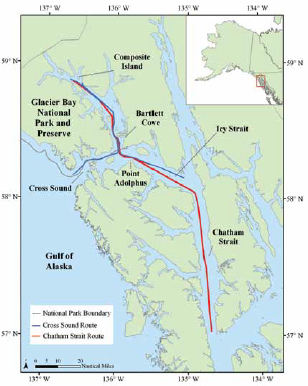
Results and Discussion
A total of 49 trips were taken in 2008 and 2009. Ships typically spent nine to ten hours in the park. More than 300 hours of observation were completed during all types of weather conditions, and more than 300 encounters were recorded. The majority of encounters between ships and whales were observed at distances greater than 100 yards (90 m). Close encounters between ships and whales occurred in Icy Strait near the entrance to the park and in lower portions of Glacier Bay (Figure 5), which are hotspots of whale abundance (Noble Hendrix, personal communication 2010). Results from this study provide the first step to informing park managers where management measures are best applied to protect humpback whales.Management Implications
Future analysis will be directed at identifying factors that contribute to close encounters between cruise ships and whales, response times of humpback whales to approaching cruise ships, and spatial and temporal patterns of locations where whales surfaced in front of the cruise ship bow. This analysis will also provide further insight into mitigation measures that park managers can adopt to minimize impacts to humpback whales in and around Glacier Bay. Improved understanding of ship and whale encounters can inform managers of where within the park whales are at greatest risk for being negatively impacted by cruise ships and when during the cruise season close encounters most often occur. Also, information on factors that contribute to close encounters and whale response times can further elucidate measures that both cruise operators and managers can take to minimize impacts to whales.
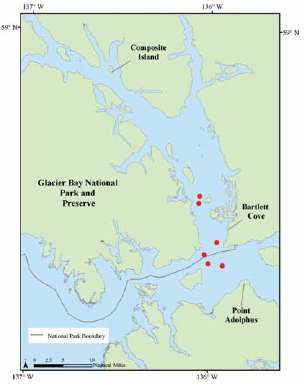
Acknowledgements
Special thanks to N. Drumheller, B. Eichenlaub, C. Gabriele, and J. Nielson for their assistance in this project. Many thanks to the captain and crew of the Holland America cruise ships, agents of the Cruise Line Agencies of Alaska, and U.S. Customs and Border protection authorities for accommodating this project and working with the observer to ensure successful embarkation and disembarkation from cruise ships. Support for this project was provided by Glacier Bay National Park and Preserve, the National Park Service, National Park Foundation, National Fish and Wildlife Foundation, University of Alaska Southeast and University of Washington.References
Doherty, J.L., and C.M. Gabriele. 2001.
Population characteristics of humpback whales in Glacier Bay and adjacent waters: 2001. Report to the National Park Service. Gustavus, AK.
Doherty, J.L., and C.M. Gabriele. 2004.
Results of humpback whale population monitoring in Glacier Bay and adjacent waters: 2004. Report to the National Park Service. Gustavus, AK.
Gabriele C.M., A.S. Jensen, J.L. Neilson, and J.M. Straley. 2007.
Preliminary summary of reported whale–vessel col-lisions in Alaskan waters: 1978-2006. 59th Annual International Whaling Commission, SC/59/BC/.
